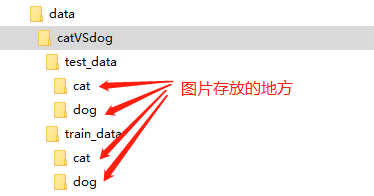大家好,我是红石!
上一篇文章:
手撕 CNN 经典网络之 VGGNet(理论篇)
详细介绍了 VGGNet 今天我们将使用网络结构 PyTorch 来复现VGGNet网络,并用VGGNet解决经典模型Kaggle图像识别比赛问题。
正文开始!
1. 数据集制作
在论文中AlexNet作者用的是ILSVRC 2012年的数据集非常大(有138G),下载和训练都需要时间,所以我们在复制时不需要这个数据集。由于MNIST、CIFAR10、CIFAR这些数据集的图片尺寸较小,不符合AlexNet网络输入尺寸227x因此,我们改用了227的要求kaggle经典的猫狗大战数据集。
该数据集包含25000张训练集,猫狗12500张,带标签;测试集共12500张,无标签。我们只使用带标签的2.5万张图片,分别拿出2.5万张猫狗图片作为模型验证集。我们根据以下目录层次结构放置数据集图片。

为方便大家训练,我们将数据集放在百度云盘上,下载链接:
链接:https://pan.baidu.com/s/1UEOzxWWMLCUoLTxdWUkB4A
提取码:cdue
准备好数据集后,我们需要使用它PyTorch可用于训练和测试的数据集试的数据集。对于训练集和测试集,首先要制作相应的图片数据索引,即train.txt和test.txt两份文件,每份txt中包含每个图片的目录和对应类别class(cat对应的label=0,dog对应的label=1)。示意图如下:
制作图片数据索引train.txt和test.txt两个文件的python脚本程序如下:
importos train_txt_path=os.path.join("data","catVSdog","train.txt") train_dir=os.path.join("data","catVSdog","train_data") valid_txt_path=os.path.join("data","catVSdog","test.txt") valid_dir=os.path.join("data","catVSdog","test_data") defgen_txt(txt_path,img_dir): f=open(txt_path,'w') forroot,s_dirs,_inos.walk(img_dir,topdown=True):#获取train文件下文件夹的名称 forsub_dirins_dirs: i_dir=os.path.join(root,sub_dir)#获取各种文件夹绝对路径 img_list=os.listdir(i_dir)#所有获取类别文件夹png图片的路径 foriinrange(len(img_list)): ifnotimg_list[i].endswith('jpg'):#若不是png文件,跳过 continue #label=(img_list[i].split('.')[0]=='cat')?0:1 label=img_list[i].split('.')[0] #将字符类别转换为整形类型表示 iflabel=='cat': label='0' else: label='1' img_path=os.path.join(i_dir,img_list[i]) line=img_path '' label '\n' f.write(line) f.close() if__name__=='__main__': gen_txt(train_txt_path,train_dir) gen_txt(valid_txt_path,valid_dir)操作脚本后./data/catVSdog生成/目录train.txt和test.txt两个索引文件。
PyTorch 加载自己的数据集,需要写继承自己的数据集torch.utils.data中Dataset类,并修改其中的__init__方法、__getitem__方法、__len__方法。默认加载的都是图片,__init__目的是获得包含数据和标签的目的list,每个元素都能找到图片的位置及其对应的标签。然后用__getitem__该方法将图像素矩阵和标签返回到每个元素img和label。
fromPILimportImage fromtorch.utils.dataimportDataset classMyDatast(Dataset):
def __init__(self, txt_path, transform = None, target_transform = None):
fh = open(txt_path, 'r')
imgs = []
for line in fh:
line = line.rstrip()
words = line.split()
imgs.append((words[0], int(words[1]))) # 类别转为整型int
self.imgs = imgs
self.transform = transform
self.target_transform = target_transform
def __getitem__(self, index):
fn, label = self.imgs[index]
img = Image.open(fn).convert('RGB')
#img = Image.open(fn)
if self.transform is not None:
img = self.transform(img)
return img, label
def __len__(self):
return len(self.imgs)getitem是核心函数。self.imgs是一个list,self.imgs[index]是一个str,包含图片路径,图片标签,这些信息是从上面生成的txt文件中读取;利用Image.open对图片进行读取,注意这里的img是单通道还是三通道的;self.transform(img)对图片进行处理,这个transform里边可以实现减均值、除标准差、随机裁剪、旋转、翻转、放射变换等操作。
当Mydataset构建好,剩下的操作就交给DataLoder来加载数据集。在DataLoder中,会触发Mydataset中的getiterm函数读取一张图片的数据和标签,并拼接成一个batch返回,作为模型真正的输入。
pipline_train = transforms.Compose([
#transforms.RandomResizedCrop(224),
transforms.RandomHorizontalFlip(), #随机旋转图片
#将图片尺寸resize到224x224
transforms.Resize((224,224)),
#将图片转化为Tensor格式
transforms.ToTensor(),
#正则化(当模型出现过拟合的情况时,用来降低模型的复杂度)
transforms.Normalize((0.5, 0.5, 0.5), (0.5, 0.5, 0.5))
#transforms.Normalize(mean = [0.485, 0.456, 0.406],std = [0.229, 0.224, 0.225])
])
pipline_test = transforms.Compose([
#将图片尺寸resize到224x224
transforms.Resize((224,224)),
transforms.ToTensor(),
transforms.Normalize((0.5, 0.5, 0.5), (0.5, 0.5, 0.5))
#transforms.Normalize(mean = [0.485, 0.456, 0.406],std = [0.229, 0.224, 0.225])
])
train_data = MyDataset('./data/catVSdog/train.txt', transform=pipline_train)
test_data = MyDataset('./data/catVSdog/test.txt', transform=pipline_test)
#train_data 和test_data包含多有的训练与测试数据,调用DataLoader批量加载
trainloader = torch.utils.data.DataLoader(dataset=train_data, batch_size=64, shuffle=True)
testloader = torch.utils.data.DataLoader(dataset=test_data, batch_size=32, shuffle=False)
# 类别信息也是需要我们给定的
classes = ('cat', 'dog') # 对应label=0,label=1在数据预处理中,我们将图片尺寸调整到224x224,符合VGGNet网络的输入要求。均值mean = [0.5, 0.5, 0.5],方差std = [0.5, 0.5, 0.5],然后使用transforms.Normalize进行归一化操作。
我们来看一下最终制作的数据集图片和它们对应的标签:
examples = enumerate(trainloader)
batch_idx, (example_data, example_label) = next(examples)
# 批量展示图片
for i in range(4):
plt.subplot(1, 4, i + 1)
plt.tight_layout() #自动调整子图参数,使之填充整个图像区域
img = example_data[i]
img = img.numpy() # FloatTensor转为ndarray
img = np.transpose(img, (1,2,0)) # 把channel那一维放到最后
img = img * [0.5, 0.5, 0.5] + [0.5, 0.5, 0.5]
#img = img * [0.229, 0.224, 0.225] + [0.485, 0.456, 0.406]
plt.imshow(img)
plt.title("label:{}".format(example_label[i]))
plt.xticks([])
plt.yticks([])
plt.show()2. 搭建VGGNet神经网络结构
class VGG(nn.Module):
def __init__(self, features, num_classes=2, init_weights=False):
super(VGG, self).__init__()
self.features = features
self.classifier = nn.Sequential(
nn.Linear(512*7*7, 500),
nn.ReLU(True),
nn.Dropout(p=0.5),
nn.Linear(500, 20),
nn.ReLU(True),
nn.Dropout(p=0.5),
nn.Linear(20, num_classes)
)
if init_weights:
self._initialize_weights()
def forward(self, x):
# N x 3 x 224 x 224
x = self.features(x)
# N x 512 x 7 x 7
x = torch.flatten(x, start_dim=1)
# N x 512*7*7
x = self.classifier(x)
return x
def _initialize_weights(self):
for m in self.modules():
if isinstance(m, nn.Conv2d):
# nn.init.kaiming_normal_(m.weight, mode='fan_out', nonlinearity='relu')
nn.init.xavier_uniform_(m.weight)
if m.bias is not None:
nn.init.constant_(m.bias, 0)
elif isinstance(m, nn.Linear):
nn.init.xavier_uniform_(m.weight)
# nn.init.normal_(m.weight, 0, 0.01)
nn.init.constant_(m.bias, 0)
def make_features(cfg: list):
layers = []
in_channels = 3
for v in cfg:
if v == "M":
layers += [nn.MaxPool2d(kernel_size=2, stride=2)]
else:
conv2d = nn.Conv2d(in_channels, v, kernel_size=3, padding=1)
layers += [conv2d, nn.ReLU(True)]
in_channels = v
return nn.Sequential(*layers)
cfgs = {
'vgg11': [64, 'M', 128, 'M', 256, 256, 'M', 512, 512, 'M', 512, 512, 'M'],
'vgg13': [64, 64, 'M', 128, 128, 'M', 256, 256, 'M', 512, 512, 'M', 512, 512, 'M'],
'vgg16': [64, 64, 'M', 128, 128, 'M', 256, 256, 256, 'M', 512, 512, 512, 'M', 512, 512, 512, 'M'],
'vgg19': [64, 64, 'M', 128, 128, 'M', 256, 256, 256, 256, 'M', 512, 512, 512, 512, 'M', 512, 512, 512, 512, 'M'],
}
def vgg(model_name="vgg16", **kwargs):
assert model_name in cfgs, "Warning: model number {} not in cfgs dict!".format(model_name)
cfg = cfgs[model_name]
model = VGG(make_features(cfg), **kwargs)
return model首先,我们从VGG 6个结构中选择了A、B、D、E这四个来搭建模型,建立的cfg字典包含了这4个结构。例如对于vgg16,[64, 64, 'M', 128, 128, 'M', 256, 256, 256, 'M', 512, 512, 512, 'M', 512, 512, 512, 'M']表示了卷积层的结构。64表示conv3-64,'M'表示maxpool,128表示conv3-128,256表示conv3-256,512表示conv3-512。
选定好哪个VGG结构之后,将该列表传入到函数make_features()中,构建VGG的卷积层,函数返回实例化模型。例如我们来构建vgg16的卷积层结构并打印看看:
cfg = cfgs['vgg16']
make_features(cfg)定义VGG类的时候,参数num_classes指的是类别的数量,由于我们这里的数据集只有猫和狗两个类别,因此这里的全连接层的神经元个数做了微调。num_classes=2,输出层也是两个神经元,不是原来的1000个神经元。FC4096由原来的4096个神经元分别改为500、20个神经元。这里的改动大家注意一下,根据实际数据集的类别数量进行调整。整个网络的其它结构跟论文中的完全一样。
函数initialize_weights()是对网络参数进行初始化操作,这里我们默认选择关闭初始化操作。
函数forward()定义了VGG网络的完整结构,这里注意最后的卷积层输出的featureMap是N x 512 x 7 x 7,N表示batchsize,需要将其展开为一维向量,方便与全连接层连接。
3. 将定义好的网络结构搭载到GPU/CPU,并定义优化器
#创建模型,部署gpu
device = torch.device("cuda" if torch.cuda.is_available() else "cpu")
model_name = "vgg16"
model = vgg(model_name=model_name, num_classes=2, init_weights=True)
model.to(device)
#定义优化器
loss_function = nn.CrossEntropyLoss()
optimizer = optim.Adam(model.parameters(), lr=0.0001)4. 定义训练过程
def train_runner(model, device, trainloader, loss_function, optimizer, epoch):
#训练模型, 启用 BatchNormalization 和 Dropout, 将BatchNormalization和Dropout置为True
model.train()
total = 0
correct =0.0
#enumerate迭代已加载的数据集,同时获取数据和数据下标
for i, data in enumerate(trainloader, 0):
inputs, labels = data
#把模型部署到device上
inputs, labels = inputs.to(device), labels.to(device)
#初始化梯度
optimizer.zero_grad()
#保存训练结果
outputs = model(inputs)
#计算损失和
#loss = F.cross_entropy(outputs, labels)
loss = loss_function(outputs, labels)
#获取最大概率的预测结果
#dim=1表示返回每一行的最大值对应的列下标
predict = outputs.argmax(dim=1)
total += labels.size(0)
correct += (predict == labels).sum().item()
#反向传播
loss.backward()
#更新参数
optimizer.step()
if i % 100 == 0:
#loss.item()表示当前loss的数值
print("Train Epoch{} \t Loss: {:.6f}, accuracy: {:.6f}%".format(epoch, loss.item(), 100*(correct/total)))
Loss.append(loss.item())
Accuracy.append(correct/total)
return loss.item(), correct/total5. 定义测试过程
def test_runner(model, device, testloader):
#模型验证, 必须要写, 否则只要有输入数据, 即使不训练, 它也会改变权值
#因为调用eval()将不启用 BatchNormalization 和 Dropout, BatchNormalization和Dropout置为False
model.eval()
#统计模型正确率, 设置初始值
correct = 0.0
test_loss = 0.0
total = 0
#torch.no_grad将不会计算梯度, 也不会进行反向传播
with torch.no_grad():
for data, label in testloader:
data, label = data.to(device), label.to(device)
output = model(data)
test_loss += F.cross_entropy(output, label).item()
predict = output.argmax(dim=1)
#计算正确数量
total += label.size(0)
correct += (predict == label).sum().item()
#计算损失值
print("test_avarage_loss: {:.6f}, accuracy: {:.6f}%".format(test_loss/total, 100*(correct/total)))6. 运行
#调用
epoch = 20
Loss = []
Accuracy = []
for epoch in range(1, epoch+1):
print("start_time",time.strftime('%Y-%m-%d %H:%M:%S',time.localtime(time.time())))
loss, acc = train_runner(model, device, trainloader, loss_function, optimizer, epoch)
Loss.append(loss)
Accuracy.append(acc)
test_runner(model, device, testloader)
print("end_time: ",time.strftime('%Y-%m-%d %H:%M:%S',time.localtime(time.time())),'\n')
print('Finished Training')
plt.subplot(2,1,1)
plt.plot(Loss)
plt.title('Loss')
plt.show()
plt.subplot(2,1,2)
plt.plot(Accuracy)
plt.title('Accuracy')
plt.show()经历 20 次 epoch 的 loss 和 accuracy 曲线如下:
经过20个epoch的训练之后,accuracy达到了94.68%。
注意,由于 VGGNet网络比较大,用CPU会跑得很慢甚至直接卡顿,建议使用GPU训练。
7. 保存模型
print(model)
torch.save(model, './models/vgg-catvsdog.pth') #保存模型VGGNet 的模型会打印出来,并将模型模型命令为 vgg-catvsdog.pth 保存在固定目录下。
8. 模型测试
下面使用一张猫狗大战测试集的图片进行模型的测试。
from PIL import Image
import numpy as np
if __name__ == '__main__':
device = torch.device('cuda' if torch.cuda.is_available() else 'cpu')
model = torch.load('./models/vgg-catvsdog.pth') #加载模型
model = model.to(device)
model.eval() #把模型转为test模式
#读取要预测的图片
# 读取要预测的图片
img = Image.open("./images/test_dog.jpg") # 读取图像
#img.show()
plt.imshow(img) # 显示图片
plt.axis('off') # 不显示坐标轴
plt.show()
# 导入图片,图片扩展后为[1,1,32,32]
trans = transforms.Compose(
[
transforms.Resize((227,227)),
transforms.ToTensor(),
transforms.Normalize((0.5, 0.5, 0.5), (0.5, 0.5, 0.5))
#transforms.Normalize(mean = [0.485, 0.456, 0.406],std = [0.229, 0.224, 0.225])
])
img = trans(img)
img = img.to(device)
img = img.unsqueeze(0) #图片扩展多一维,因为输入到保存的模型中是4维的[batch_size,通道,长,宽],而普通图片只有三维,[通道,长,宽]
# 预测
# 预测
classes = ('cat', 'dog')
output = model(img)
prob = F.softmax(output,dim=1) #prob是2个分类的概率
print("概率:",prob)
value, predicted = torch.max(output.data, 1)
predict = output.argmax(dim=1)
pred_class = classes[predicted.item()]
print("预测类别:",pred_class)输出:
概率: tensor([[7.6922e-08, 1.0000e+00]], device='cuda:0', grad_fn=<SoftmaxBackward>)
预测类别: dog
模型预测结果正确!
好了,以上就是使用 PyTorch 复现 VGGNet 网络的核心代码。建议大家根据文章内容完整码一下代码,可以根据实际情况使用自己的数据集,并对网络结构进行微调。
完整代码我已经放在了 GitHub 上,地址:
https://github.com/RedstoneWill/CNN_PyTorch_Beginner/blob/main/VGGNet/VGGNet.ipynb
手撕 CNN 经典网络之 LeNet-5(理论篇)
手撕 CNN 经典网络之 LeNet-5(MNIST 实战篇)
手撕 CNN 经典网络之 LeNet-5(CIFAR10 实战篇)
手撕 CNN 经典网络之 LeNet-5(自定义实战篇)
手撕 CNN 经典网络之 AlexNet(理论篇)
手撕 CNN 经典网络之 AlexNet(PyTorch 实战篇)
手撕 CNN 经典网络之 VGGNet(理论篇)
(点击标题可跳转阅读)
干货 | 公众号历史文章精选
我的深度学习入门路线
我的机器学习入门路线图
!
AI有道年度技术文章电子版PDF来啦!
扫描下方二维码,添加 AI有道小助手微信,可申请入群,并获得2020完整技术文章合集PDF(一定要备注:
(添加人数较多,请耐心等待)